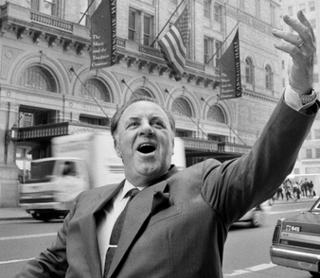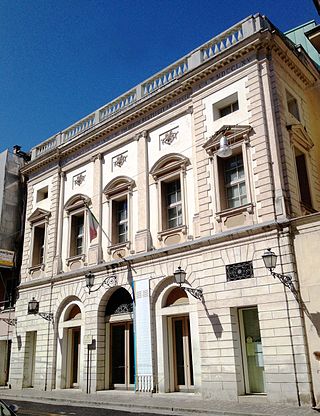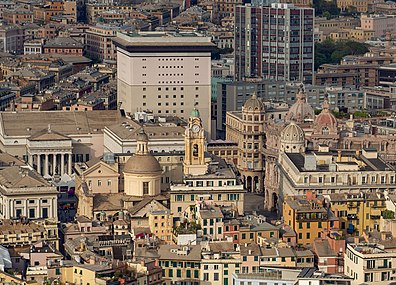
La Scala is a historic opera house in Milan, Italy. The theatre was inaugurated on 3 August 1778 and was originally known as il Nuovo Regio Ducale Teatro alla Scala. The premiere performance was Antonio Salieri's Europa riconosciuta.

The Teatro Colón is a historic opera house in Buenos Aires, Argentina. It is considered one of the ten best opera houses in the world by National Geographic. According to a survey carried out by the acoustics expert Leo Beranek among leading international opera and orchestra directors, the Teatro Colón has the room with the best acoustics for opera and the second best for concerts in the world.

Carlo Bergonzi was an Italian operatic tenor. Although he performed and recorded some bel canto and verismo roles, he was above all associated with the operas of Giuseppe Verdi, including many of the composer's lesser known works he helped revive. He sang more than forty other roles throughout his career.

The Real Teatro di San Carlo, as originally named by the Bourbon monarchy but today known simply as the Teatro (di) San Carlo, is a historic opera house in Naples, Italy, connected to the Royal Palace and adjacent to the Piazza del Plebiscito. It is the oldest continuously active venue for opera in the world, having opened in 1737, decades before either Milan's La Scala or Venice's La Fenice.

The Teatro Comunale di Bologna is an opera house in Bologna, Italy. Typically, it presents eight operas with six performances during its November to April season.

Teatro Regio di Parma, originally constructed as the Nuovo Teatro Ducale, is an opera house and opera company in Parma, Italy.

The Teatro dell'Opera di Roma is an opera house in Rome, Italy. Originally opened in November 1880 as the 2,212 seat Costanzi Theatre, it has undergone several changes of name as well modifications and improvements. The present house seats 1,560.

The Teatro della Pergola, sometimes known as just La Pergola, is a historic opera house in Florence, Italy. It is located in the centre of the city on the Via della Pergola, from which the theatre takes its name. It was built in 1656 under the patronage of Cardinal Gian Carlo de' Medici to designs by the architect Ferdinando Tacca, son of the sculptor Pietro Tacca; its inaugural production was the opera buffa, Il potestà di Colognole by Jacopo Melani. The opera house, the first to be built with superposed tiers of boxes rather than raked semi-circular seating in the Roman fashion, is considered to be the oldest in Italy, having occupied the same site for more than 350 years.

The Teatro Comunale di Firenze is an opera house in Florence, Italy. It was originally built as the open-air amphitheatre, the Politeama Fiorentino Vittorio Emanuele, which was inaugurated on 17 May 1862 with a production of Donizetti's Lucia di Lammermoor and which seated 6,000 people. It became the focus on cultural life in the city. After closure caused by fire, it reopened in April 1864 and acquired a roof in 1882. By 1911 it had both electricity and heating.

The Teatro Dal Verme is a theatre in Milan, Italy located on the Via San Giovanni sul Muro, on the site of the former private theatre the Politeama Ciniselli. It was designed by Giuseppe Pestagalli to a commission from Count Francesco Dal Verme, and was used primarily for plays and opera performances throughout the 19th and early 20th centuries. Today, the theatre is no longer used for opera, but is a venue for concerts, plays and dance performances, as well as exhibitions and conferences.

Ildikó Komlósi is a Hungarian mezzo-soprano.

Piazza De Ferrari is the main square of Genoa. Situated in the heart of the city between the historical and the modern center, Piazza De Ferrari is renowned for its fountain, which was restored in recent years along with a major restyling of the square.

Angelo Maurizio Gaspare Mariani was an Italian opera conductor and composer. His work as a conductor drew praise from Giuseppe Verdi, Giacomo Meyerbeer, Gioachino Rossini and Richard Wagner, and he was a longtime personal friend of Verdi's, although they had a falling out towards the end of Mariani's life. He conducted at least two world premieres ; and at least 4 Italian premieres.

Aldo Bertocci was an Italian operatic tenor who sang both comprimario and leading roles in a career spanning the late 1940s to the mid-1970s. He sang in the world premieres of nine 20th century operas, most of them in performances broadcast on the RAI, Italy's national public-service radio. His discography includes live recordings of several rarities such as Mascagni's Silvano and Leoncavallo's Zingari. Bertocci was born in Turin and from 1974 lived in Cassano Valcuvia where he died shortly before his 88th birthday.

The Teatro Flavio Vespasiano is the main theatre and opera house in Rieti. It was opened on 20 September 1893, after ten years of work and finishing touches; directed by architect Achille Sfondrini. It takes its name from the Roman emperor Titus Flavius Vespasian who was born in sabina.
Giovine Orchestra Genovese is an Italian music organization, concert society and cultural association, founded in 1912 in Genoa by Giovanni Semeria. A nonprofit organization, it organizes and produces classical and chamber music concerts and promotes musical education for students.
Alvise Casellati is an Italian conductor.

The Teatro Mario Del Monaco is an opera house and theatre in Treviso, Italy. It was previously known as the Teatro Onigo from 1692 to 1846, the Teatro Sociale from 1847 to 1930, and the Teatro Comunale from 1931 to 2011. In 2011, it was renamed in honour of the Italian tenor Mario Del Monaco who lived in Treviso from 1975 until his death in 1982. It is located in the historic centre of the city on the Corso del Popolo and since 2019 has been run by the Teatro Stabile del Veneto which also runs the Teatro Goldoni in Venice and the Teatro Verdi in Padua.

The Amintore Galli Theatre, formerly the New Municipal Theatre and the Victor Emmanuel II Theatre is an opera house and theatre in Rimini, in the region of Emilia-Romagna, Italy.

Teatro Coccia is the main opera house in Novara, and is also the most important "historical" theatres in Piedmont. It faces along via Fratelli Rosselli, and delimits piazza dei Martiri to the west and piazza Giacomo Puccini to the east.
























